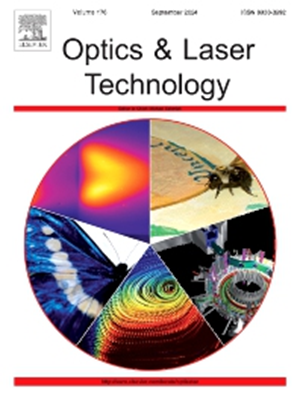Resonance mechanism in composite material hollow core fiber
IF 5
2区 物理与天体物理
Q1 OPTICS
引用次数: 0
Abstract
In this study, we derived the characteristic equation for dielectric modes in composite material dielectric tubes and analyzed the resonance mechanism of composite material antiresonant fibers based on the inhibited coupling theory. A simplified cutoff equation was also proposed, successfully predicting the separation of loss peaks for electric-dominant modes (TM and EH) and magnetic-dominant modes (TE and HE) in composite material antiresonant fibers. The results from both the characteristic and cutoff equations demonstrated great agreement with finite element method simulations. The proposed model simplifies the design process by reducing the computational complexity compared to traditional methods. Additionally, it provides valuable insights into the waveguide behavior and loss mechanisms of composite material antiresonant fibers, aiding in the optimization of these fibers for practical applications in areas such as high-speed communication and sensitive sensing. This work offers a more efficient approach to understanding and designing composite material antiresonant fibers, contributing to the advancement of fiber-optic technology.
复合材料空心芯纤维的共振机理
在本研究中,我们推导了复合材料介质管中介电模式的特征方程,并基于抑制耦合理论分析了复合材料抗谐振光纤的谐振机理。提出了一个简化的截止方程,成功地预测了复合材料抗谐振光纤中电优势模式(TM和EH)和磁优势模式(TE和HE)的损耗峰分离。特征方程和截止方程的计算结果与有限元模拟结果非常吻合。与传统方法相比,该模型通过降低计算复杂度,简化了设计过程。此外,它为复合材料抗谐振光纤的波导行为和损耗机制提供了有价值的见解,有助于优化这些光纤在高速通信和敏感传感等领域的实际应用。这项工作为理解和设计复合材料抗谐振光纤提供了一种更有效的方法,有助于光纤技术的进步。
本文章由计算机程序翻译,如有差异,请以英文原文为准。
求助全文
约1分钟内获得全文
求助全文
来源期刊
CiteScore
8.50
自引率
10.00%
发文量
1060
审稿时长
3.4 months
期刊介绍:
Optics & Laser Technology aims to provide a vehicle for the publication of a broad range of high quality research and review papers in those fields of scientific and engineering research appertaining to the development and application of the technology of optics and lasers. Papers describing original work in these areas are submitted to rigorous refereeing prior to acceptance for publication.
The scope of Optics & Laser Technology encompasses, but is not restricted to, the following areas:
•development in all types of lasers
•developments in optoelectronic devices and photonics
•developments in new photonics and optical concepts
•developments in conventional optics, optical instruments and components
•techniques of optical metrology, including interferometry and optical fibre sensors
•LIDAR and other non-contact optical measurement techniques, including optical methods in heat and fluid flow
•applications of lasers to materials processing, optical NDT display (including holography) and optical communication
•research and development in the field of laser safety including studies of hazards resulting from the applications of lasers (laser safety, hazards of laser fume)
•developments in optical computing and optical information processing
•developments in new optical materials
•developments in new optical characterization methods and techniques
•developments in quantum optics
•developments in light assisted micro and nanofabrication methods and techniques
•developments in nanophotonics and biophotonics
•developments in imaging processing and systems

 求助内容:
求助内容: 应助结果提醒方式:
应助结果提醒方式:


